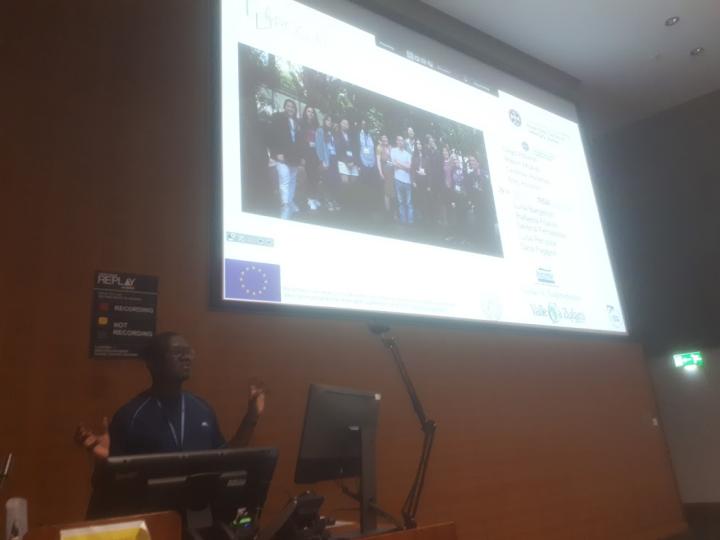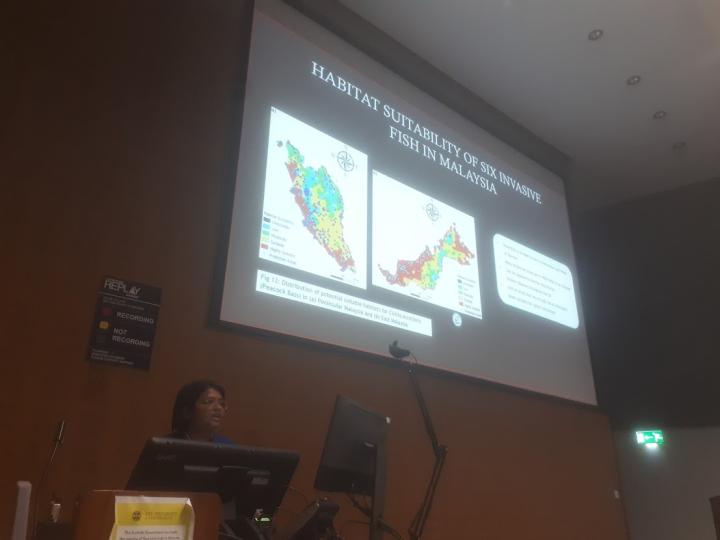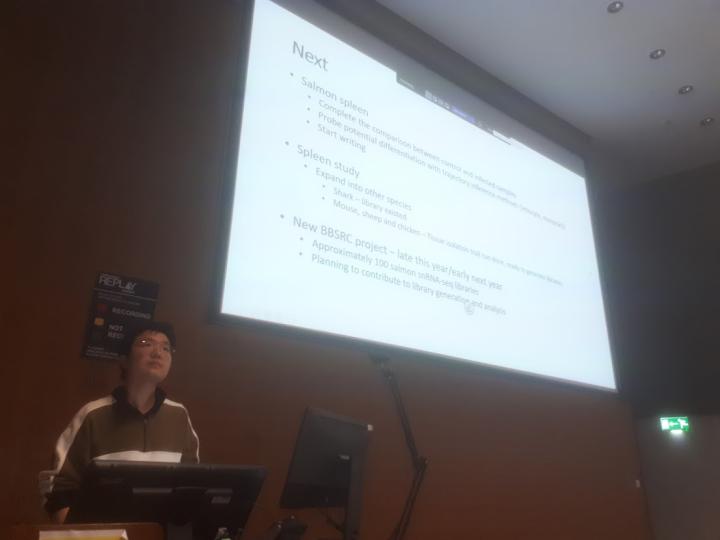Entire Aquaculture group convenes for summer
Jianxuan, Lavanya, and Robert presented work for discussion at our second mass meeting.
15/7/2022
In late June, the entirety of the Aquaculture team at the Roslin Institute gathered for their next mass meeting, in which one representative from each group gives a presentation on their ongoing work while the rest of the team discusses their findings. These meetings provide a larger audience for feedback than each group’s typical lab meetings and gives PhD students, postdoctoral research fellows, and group leaders alike the opportunity to practice and fine-tune presentations—and to take on the suggestions of their colleagues in a collaborative, cooperative environment. At this lab meeting, the team heard from Robert Mukiibi, Lavanya Vythalingam, and Jianxuan Sun.

Robert presented results from his work on farmed European seabass within the ongoing H2020 AQUA-FAANG project. European seabass is an economically important species in Europe that is vulnerable to nervous necrosis virus (NNV), a virus affecting the central nervous system, which is a threat to many marine fish species. Resistance to the disease is heritable, but research has not yet pinpointed the genes which determine this resistance; Robert and his colleagues are trying to find the mechanisms which underpin resistance to NNV.
After generating a population of 1,029 offspring from 25 males and 25 females, Robert and colleagues ran a month-long disease challenge. All these animals were genotyped for a total of 8.4 million imputed variants.
Working alongside his teammates, Robert reconstructed the pedigree and examined phenotype data to find evidence of familial variability and survivability. The team’s heritability estimations are consistent with previous studies and their research has revealed numerous other exciting results.
Robert’s work confirmed the presence of a major QTL which could be used for marked assisted selection. The group identified two genes with strong potential to be the causal genes for resistance based on extensive RNA-Seq data. These findings prompted inquiries from group leaders and discussion amongst the rest of the team.
You can find out more about Robert and his work via his People page.

Lavanya began her presentation by providing details about her PhD research in her home country, Malaysia, which benefits from extraordinary biodiversity yet is threatened by environmental challenges. There are many critically endangered species within Malaysia, particularly among its many freshwater fish, and the delicate biomes in which they live are juxtaposed by an aquarium industry of imported fish—some of which, when introduced to the wild, can prey on native animals or compete with them for resources. Lavanya’s PhD research sought to help combat the negative impact of invasive species via the DNA-based Loop Mediated Isothermal Amplification (LAMP) system of species identification, which she’s used to detect and identify them.
Lavanya’s aim of creating a tool for identification usable in the field without over-extensive training made Group Leader Tim Bean’s work on oysters in the UK of particular interest. Based on her findings and the field work in which she has participated, Lavanya believes that both the tools and the approach used for identifying disease in oyster beds should be preventative rather than reactive; typically, disease testing of oysters is only initiated after a mass mortality event takes place or seems highly likely, and results can take days or weeks to arrive. Because of both disease and overexploitation, the UK’s oyster industry suffered severely in the 20th century. However, the pathogen detection tool Lavanya and her colleagues recently put to use while in the field can provide results in less than two days, including the time required for quarantine and incubation, and doesn’t necessitate sacrificing the studied animals for the sake of the research.
Lavanya had also used species distribution modelling in her PhD; she would like to deploy the same forms of suitability modelling used in Malaysia for oyster pathogens in the UK. The development of user-friendly, in-field testing in high-risk areas would allow farmers to regularly check for disease and other threats.
The group had many questions following on from Lavan’s presentation, particularly relating to the tools she used. Much of this dealt with distinctions between tools for fish species and oyster species, as farming them is quite difficult—leading to different needs for farmers. The group also noted that the potential from Lavanya’s work for restoration programs across the UK, which seek to reintroduce oysters to areas of the UK where they’d previously died out, is enormous.
You can learn more about Lavanya's work in the field via our previous news story.
More information about Lavanya's studies can be found on her People page.

Jianxuan spoke to the team about his first year as a PhD student at Roslin and his project on comparative single-cell transcriptomic analysis in farm animals. Addressing problems posed to animal production by infectious diseases, Jianxuan’s research focuses on determining cell function within the immune system. While our knowledge of the human immune system is extensive in a few species (humans and mice, for example), there is still much we can learn about the immune systems of farmed animal species, from chicken to salmon.
Jianxuan has been using single-cell sequencing in his research. Jianxuan clarified the distinction between bulk RNA sequencing and single-cell RNA sequencing by showing a milkshake juxtaposed by a list of its ingredients. Among other aims, Jianxuan wishes to generate and compare single-nuclei datasets in multiple species from the vertebrate tree of life, focusing on the spleen as a conserved lymphoid organ.
Jianxuan spoke about the nature of the snRNA-seq datasets he is using in his research. He explained the tools used for data mapping (including StarSolo, Cellranger, and Ensembl) as well as the tools involved in his single-cell analysis, which include Seurat, Doubletfinder, Harmony, Velocyto, and Monocle. Jianxuan shared some of his findings and progress to date investigating the salmon spleen, through which he has identified a range of different immune cell types. Jianxuan’s focus currently is to understand how immune heterogeneity contributes to the salmon’s response to bacterial infection.
The rest of the team asked Jianxuan more about the benefits of single-cell transcriptomics, as well as the advantages of different cell visualisation methods.
You can read more from Jianxuan via his page in the People section.
At the end of the meeting, the group spoke about many of the upcoming events which will fill this summer—including photoshoots, new facilities, and more upcoming fieldwork and conferences in the UK and beyond. The group leaders also announced a planned trip out to the University of Edinburgh’s Outdoor Centre Retreat to Loch Tay in September! This meeting was a welcome opportunity for the group to convene—and we’re already looking forward to the next one.
You can read about the last Aquaculture mass meeting through our prior News story.

